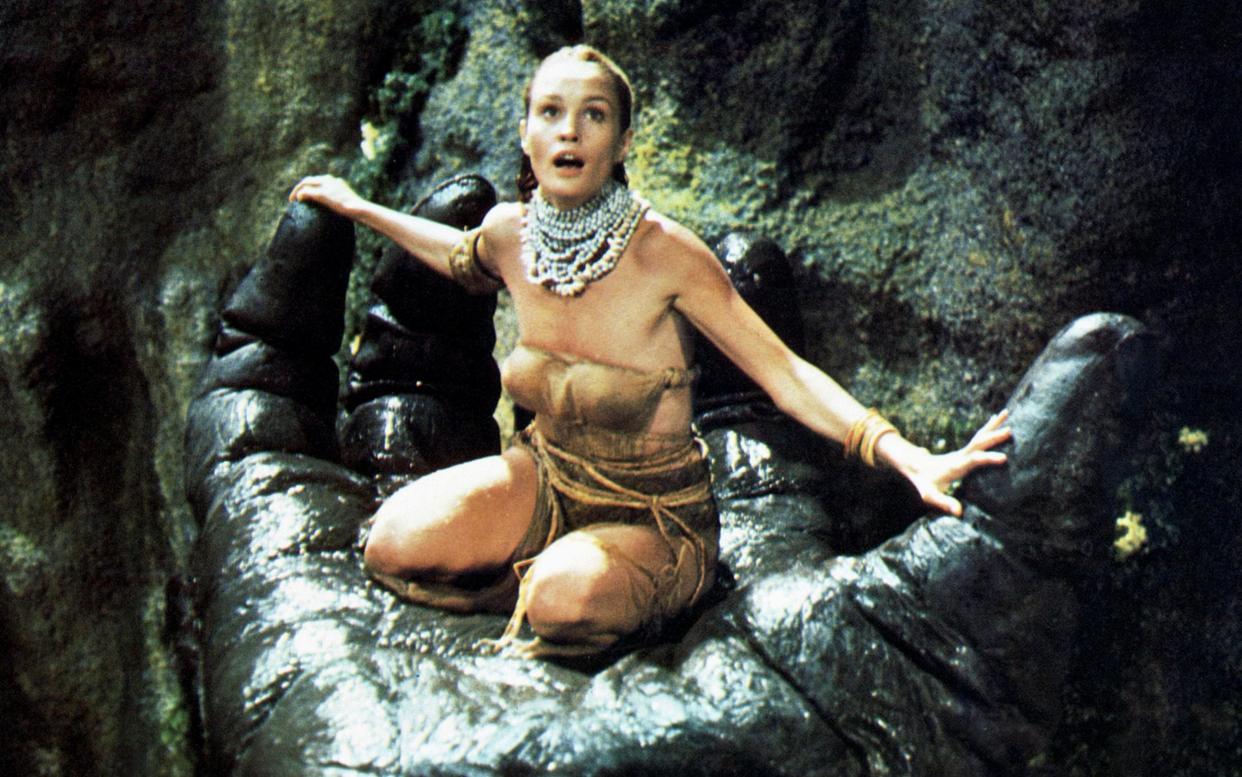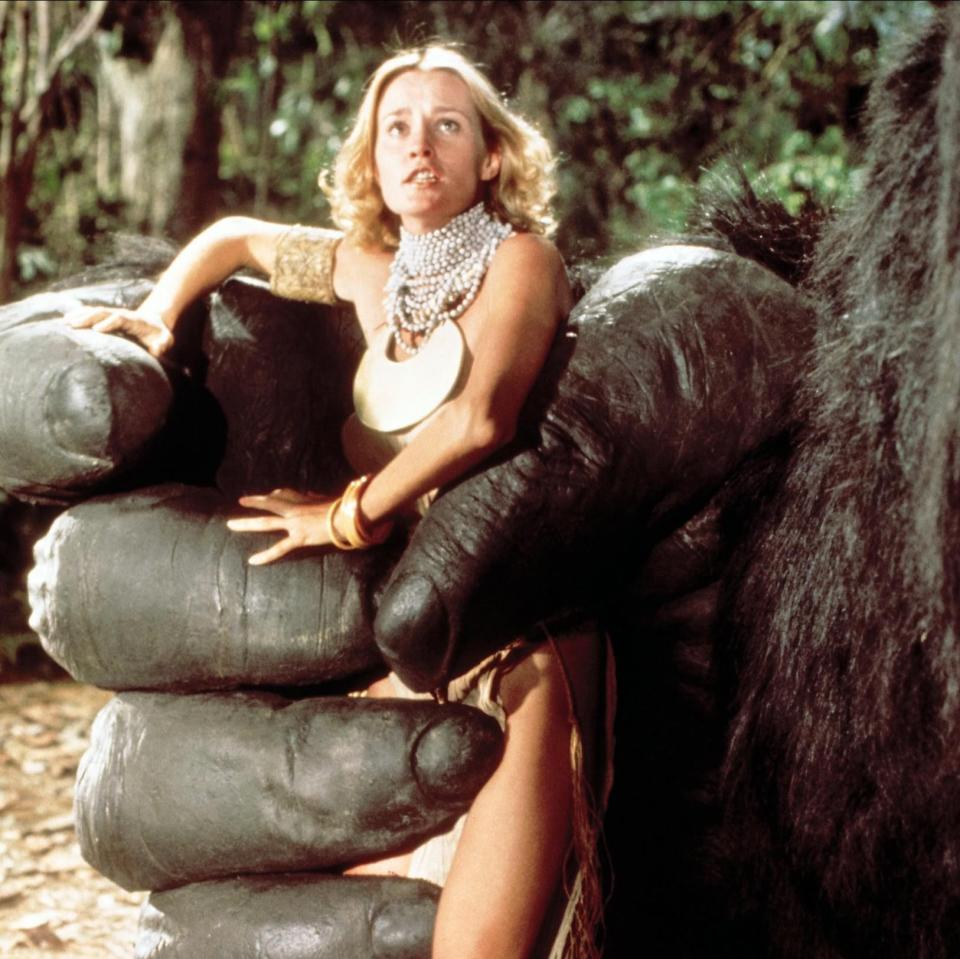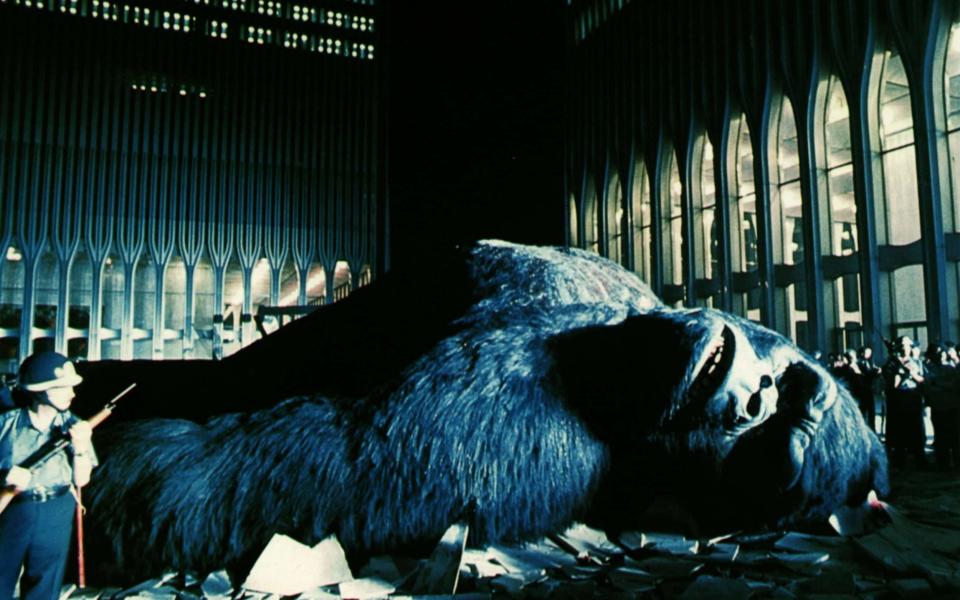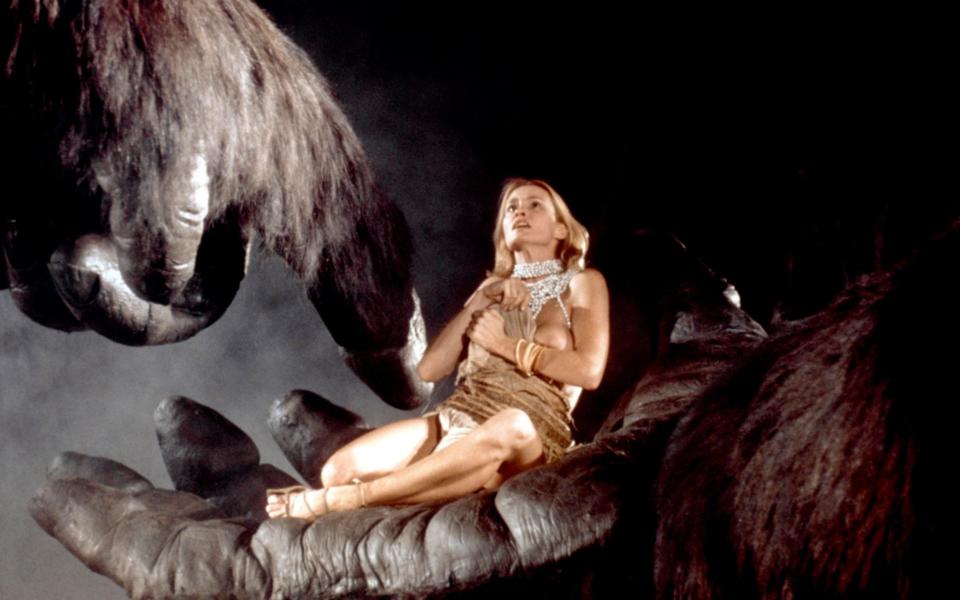The kaput King Kong that almost broke Jessica Lange

The 1976 remake of King Kong was sold on a never-before-seen, ground-shaking special effect: a 40ft, fully robotic ape.
Originally, the film was set to use a puppet-style model, but Dino De Laurentiis, the Italian producer behind the remake, was inspired by the publicity that Jaws had received for its mechanical shark. Visual effects artist Carlo Rambaldi, a two-time Academy Award-winner for his work on Alien and ET, was convinced he could create a huge animatronic ape for De Laurentiis.
Despite being warned, quite reasonably, that it wouldn’t work, the filmmakers were ambitious. Much of the film was storyboarded to include the mechanical ape. They took the design to an aircraft manufacturing company. The robot would take three years to build, said the experts, and cost $10 million.
De Laurentiis turned to visual effects man Glen Robinson, who had a sideline building theme-park rides. Robinson had a cheaper, faster solution: to build a full-size Kong powered by hydraulics. It took six months to build and – much like the shark in Jaws – looked rubbish and didn’t work. It had cost a reported $1.7 million.
The robot Kong, which the publicity machine had promised would be the star of the show, appeared in just six shots of the final movie – mere seconds of screen time. For most of the film, makeup effects maestro Rick Baker wore a dodgy ape suit.
In September 1978, almost two years after the film’s release, the 40ft Kong arrived in Buenos Aires, Argentina, now the star of a downmarket fairground attraction. Kong had been dismantled and shipped from Los Angeles; his arrival stirred up a media frenzy in the Argentine capital.
In a spectacle that mirrored the final act of King Kong, the ape was unveiled in front of aghast crowds. This time, however, Kong took questions from the audience, before the showmen yelled that Kong was about to break free – and promptly guided the punters towards the merchandise stand.
The show was a money maker, and Kong was moved to the beachside city of Mar del Plata. When business bombed, Kong was abandoned, left to withstand the autumn drizzle. Soon – and not unlike the movie in which he had fleetingly starred – the 40ft animatronic Kong disappeared.
Now, Kong has returned for an almighty monster smackdown – Godzilla vs King Kong (itself a sort-of remake of a 1963 cheapie crossover). Adam Wingard's film is getting good reviews, but few modern fans go ape for King Kong ’76. It’s naff by modern standards (it’s a bloke in a suit, after all), and yet – as directed by John Guillermin, and starring Jeff Bridges and Jessica Lange – is a wildly enjoyable, if primitive, piece of blockbuster cinema. It was also a cinematic landmark: a transitional moment for special effects and, with a budget of $25 million, one of the costliest films of its time.
Its spectacular conclusion – which relocates Kong’s iconic skyscraper ascent from the Empire State Building (as seen in the 1933 original) to the World Trade Center – could explain why it’s rarely shown. King Kong ’76 also looks like an evolutionary step back from Peter Jackson’s 2006 motion-captured remake (if you haven’t seen Jackson’s version, switch on ITV4 – it’s almost certainly playing at this very second).
Of course, the idea of any King Kong remake feels almost obscene. The original, nearly 90 years since it was first unleashed, is every bit as brilliant as its monster reputation suggests. But at the time the remake went into production, Kong was enjoying a renewed popularity – part of a resurgence of classic movies.

“King Kong was in the air in the early 1970s,” says Ray Morton, a film historian and the author of King Kong: The History of a Movie Icon. “Kids had models and toys and games, and King Kong was on television all the time.”
Kong was also on a collision course with another cinematic fad of the early 1970s: the disaster movie. Between 1972 and 1974, The Poseidon Adventure, The Towering Inferno and Earthquake all had shaken up the box office. De Laurentiis and Barry Diller, the head of Paramount, cooked up an idea for their next project.
“The appeal of the disaster movie was you could create destruction and havoc with special effects,” says Morton. “But they figured that with The Towering Inferno, Earthquake, Airport ‘75 and The Poseidon Adventure, all the good disasters had been taken! So they thought, ‘Let’s do a giant monster movie!’ They could do the same kind of large-scale destruction. But they didn’t know what kind of monster movie they wanted to make.”
“Dino was all about the big picture,” said Martha De Laurentiis, Dino’s widow, in 2016. “Whatever was epic and challenging, he would go for it.”
As Kong legend goes, De Laurentiis got the idea to use King Kong from a poster in his daughter’s bedroom. John Landis, the soon-to-be director of An American Werewolf in London, tells a different story. According to Landis, De Laurentiis called him to a meeting about writing their monster spectacular. Landis realised the movie that De Laurentiis was describing was King Kong – he just didn’t know it.

“I had this long meeting with him in his bungalow, in which I'd learned that he'd never seen King Kong,” Landis told journalist Mark Edlitz. “He'd never heard of Godzilla. He'd never seen The Beast from 20,000 Fathoms. He was kind of unschooled in big monsters. He was thinking more about the Cyclops in Ulysses. So I screened King Kong and Godzilla for him. I made a list of other movies for him to see. This went on for three or four days.”
There’s a third version of the story: that Michael Eisner – head of ABC television and future boss of Disney – came up with the idea, apparently influenced by seeing a repeat of the film, or a Bette Midler routine about Kong. “I’m guessing the truth is some version of all three stories,” says Morton.
Reportedly, Eisner mentioned the idea to Paramount’s Barry Diller and MCA/Universal boss Sid Sheinberg. Certainly, both Paramount/De Laurentiis and Universal began developing King Kong projects at the same time – unaware of each other at first. It began an expensive legal battle for Kong that New York magazine called “the silliest – and very possibly the biggest – thing that has been going on in the entertainment business”.
Universal sued for $25 million, and De Laurentiis counter-sued for $90 million. Eventually they settled, but Universal vowed to return to its own version, The Legend of King Kong, at a later date. When John Landis found out about the King Kong remake, he called his friend Rick Baker, who responded: “They’re gonna get some idiot and put him in an ape suit.” Speaking about the film on a panel in 2016, Baker described how the idea was “sacrilege” to him.
Indeed, there was a mixed reaction from Kong fans. “There was an interesting split mind about it,” Morton agrees. “Lots of people thought it was a terrible idea. But because Kong was so popular at the time, it was very commercial.”
De Laurentiis hired Lorenzo Semple Jr to write the screenplay. Semple had helped to launch the Batman TV show and later wrote the brilliantly campy Flash Gordon (also produced by De Laurentiis). Their plan was to change King Kong completely. “They thought they’d get killed if they made it too close to the original,” says Morton. “Then, of course, they got killed for making it too different.”

In the updated version, oil executive Fred Wilson (the always-funny Charles Grodin) leads a tanker expedition to an uncharted island (a spot-on update – this was in the wake of the 1970s oil crisis). A Princeton paleontologist (the young and magnificently hairy Jeff Bridges) smuggles himself aboard and warns the crew about stories of a legendary beast. En route, they rescue wannabe actress Dwan (Jessica Lange in her film debut), whom they find adrift and unconscious in a lifeboat.
As per the original, tribespeople on the island kidnap Dwan and offer her as a sacrifice to Kong – but the boat crew monkey-naps Kong and returns him to New York. This time, it’s part of a tacky publicity stunt for the oil company. Indeed, Kong is unveiled to New Yorkers from beneath a giant petrol pump (“Lorenzo Semple was a satirist at heart,” laughs Morton). Naturally, Kong breaks free and roams the city, eventually climbing the World Trade Center and leaping between the Twin Towers.
De Laurentiis wanted Roman Polanski to direct, but Polanski said, “I don’t know what to do with the monkey.” When the producer approached John Guillermin – who had also directed The Towering Inferno – Guillermin confirmed, “Yes, I know what to do with the monkey.”
The film was shot partly in Hawaii, where Guillermin was reported to have a turbulent moment with De Laurentiis’s son, Federico, an executive producer. "The director had a turbulent moment with everyone on the set!” laughs Morton. “Guillermin was a yeller and a screamer. He was a big screamer on King Kong. He got into a shouting match with Federico De Laurentiis. Dino said, ‘If you don’t stop yelling at people, I’ll fire you.’ So he settled down a little bit, I guess.”
When Rick Baker came onboard, he was horrified to discover that the team planned to make Kong into “more of an ape-man” – more Neanderthal than gorilla. “If anything, it should be a gorilla on steroids,” said Baker.
Baker also had competition from Carlo Rambaldi. Producers told Baker that they probably wouldn’t even need an ape suit from him (which he’d been specifically hired to make) because Rambaldi was building them a robot Kong. “Sounds a lot better than some 25-year-old schmuck in a gorilla suit,” Baker admitted in 2016.
Still, Baker and Rambaldi were tasked with each building a “test” ape suit. Baker tossed out the Neanderthal idea, determined to show the producers that he knew Kong better than they did.

“When they saw my suit they were pissed off,” said Baker. “[They said] ‘This doesn’t look anything like what we asked you to build…’ ‘Yeah, I know, it’s better!’”
He was right, and they ultimately selected Baker’s designs to use in the film. Baker played the role himself, though he remembered the production sparked outrage at one point when it placed a trade ad looking for an African-American actor to portray the gorilla.
Baker suffered inside the suit, which was six inches thick and covered in bear fur (a Rambaldi idea). Baker lost 5lbs in water weight each day. He also wore full-eye, hard plastic contact-lenses, which at first caused him agonising pain, and left him partially sighted on his drive home. He woke up each morning with his eyes fused shut with crusted-up mucus.
To capture scenes for the skyscraper-top climax, Baker had to stand on top of a scaffold in the suit while remote-control helicopters swirled around him. One of the helicopters knocked loose a plank of the wood, which crashed onto Baker’s shoulder. Years later he discovered that he’d broken his collarbone. After all that, Baker conceded that “it looked like a man in a suit anyway”.
The Kong suit has its moments, though. Kong’s first appearance, emerging from the jungles to snatch Dwan, is superbly shot, and later, when Kong is imprisoned and being shipped to New York, his expressions – created by a cable-operated mechanical head – are startlingly effective.
Rick Baker credited Carlo Rambaldi for designing the head, which had 40ft cables trailing behind it, allowing three people to control Kong’s expressions via levers. The sheer weight of the cables would yank Baker back with whiplash-inducing force as he walked around.
Following the tradition of the 1933 film, the ’76 remake was a Kong-sized moment for special effects: it was the last film to use old school, non-computerised optical effects, and the first to use these kinds of mechanical make-up techniques. “The original King Kong was a landmark of stop-motion animation and optical effects,” says Morton. “The remake is a landmark in what later became known as animatronics.”
Disappointingly, Kong doesn’t fight dinosaurs here – plumping instead for a punch-up with an unconvincing snake – though it’s likely a bonus in hindsight. Dinosaur effects from that era (Morton points to The Land That Time Forgot) look even dodgier now than a man in a monkey costume. Also built was a static styrofoam Kong – which was used for just one scene and cost $300,000 – and giant, mechanical ape hands for Jessica Lange to sit in and scream/flirt with Kong (in one moment she’s positively orgasmic).
The hands were controlled by a team of technicians but were dangerously troublesome. One snapped at the wrist and dropped a stunt woman from 10ft. Charles Grodin recalled in his autobiography how a giant Kong finger walloped Jessica Lange on the head: “Jessica emerged from 10 months of shooting significantly bruised from Kong, who, squeezing too hard on occasion, caused her to cry out for help.”
The full-size, hydraulically-powered Kong got his moment in a crucial scene – Kong’s big debut in New York. It’s one of the few shots featuring the much-publicised animatronic. His performance was a dud. As the giant petrol pump cover was whipped off, one of Kong’s hydraulic pipes ruptured. The big ape, with a Petrox-branded crown on his head, just stood there leaking.
In 2021, King Kong ’76 seems amusingly old-fashioned: see how Dwan is found abandoned in a boat in the middle of the ocean, but somehow finds a selection of saucy outfits on a tanker full of lascivious men. But it’s a film that knows exactly what it is – a self-aware romp made in the shadow of Kong’s already-legendary status.
“Take plenty of TNT,” Grodin’s oil exec tells a crew member before they head onto the island. “Any sign of a monkey bigger than four feet… send it bang-bang.” Later, when Kong has captured Dwan and falls in love with her, she pleads, “Oh come on, Kong, forget about me – this thing’s just never gonna work!”
“Lorenzo Semple told me that a big worry was, ‘What if modern audiences laughed at the idea?’” says Morton. “He put some lines in there that acknowledged the absurdity of it, so they could get people to laugh with it, rather than at it. When the movie came out, people got in the spirit of it.”
By contrast, the film’s climax is jarringly violent. Standing atop the World Trade Center, Kong is shot to pieces, by helicopter machine-gunfire, leaving him a gory mess. You have to wonder if the inclusion of the World Trade Center is why the film rarely gets played now. “I think it had stopped being shown before 9/11,” says Morton. “But I do think that made people reluctant to revive it.”
Released on December 17, 1976, King Kong was a sizable hit. It was the most widely released film of all time at that point (in 12,000 American cinemas) and made $90 million globally. It received a special achievement Oscar for visual effects and was nominated for two others.
The film also launched Jessica Lange’s career. She was a waitress and model when she landed the role, and De Laurentiis apparently yelled “I found my Fay Wray!” when he saw her audition. The dreamy, tongue-in-cheek Dwan might have flopped with another actress. Lange won favourable reviews despite critics not being enamoured with the character – “Likely to set everyone else’s teeth on edge,” wrote the New York Times – and won a best newcomer Golden Globe. “At that point it was better than being a waitress,” Lange later said.
As for Kong himself – the clapped-out, non-working robot version that travelled to Argentina and mysteriously disappeared – there were rumours that he’d been dumped on a nearby lot, where his rubber skin disintegrated, and only a steel ape skeleton remained. In truth, Kong was caught in a legal wrangling over his ownership, but was restored and exhibited in other countries before he ended up in storage in North Carolina.
And it wasn’t over for Kong. In 1986 there was a dreadful sequel, King Kong Lives – in which Kong is supposedly in a coma for 10 years, needs a heart transplant, and gets a blood transfusion from a newly-discovered Lady Kong (yes, really). And Universal got its slice of Kong with a popular King Kong ride at Universal Studios (“The Kong in Universal Studios worked way better than the one in the movie!” says Morton).
Next to Peter Jackson’s self-indulgent, CGI-heavy version, King Kong ’76 remains overlooked. It will at least get a new Blu-ray release in the US this May. The film’s contributions to Kong-lore are significant: it was the De Laurentiis version which dramatised the relationship between ape and woman, now a widely-recognised part of the story, and was included in Peter Jackson’s version.
“Everyone thinks that relationship is in the original movie, but it’s not,” says Morton. “Peter Jackson took all of that, which is fine, except the whole time he was making his film he kept saying what a piece of junk the 1970s one was!”
King Kong ’76 also made Kong a hero. “That’s the other thing that’s really important,” Morton adds. “In the original film, Kong is the villain – he’s a monster – but in every other film, Kong is the hero. There’s a great line that Jeff Bridges says: ‘When we took Kong, we kidnapped their god.’ He’s talking about Kong’s place in pop culture.
“We see him as this awesome, beloved figure. That’s how the Seventies film portrays him – a noble, tragic creature.”
King Kong (1976) will be released on Region 1 Blu-ray on May 11


